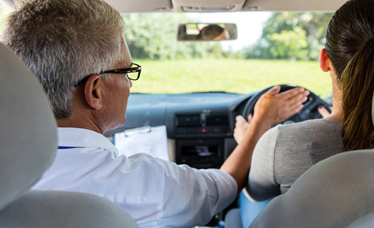Chapter 13 – Section 1
Lanes, Lines and Pavement Markings
The best drivers in the world would be hazards on the roads without boundaries. Put ten cars on the road without lanes, and chaos would reign supreme. Lanes on the road allow vehicles to share the highway safely. Knowing the laws that govern these lanes helps you become a better driver.
-
A. Lines and Pavement Markings
-
-
1. Double Yellows
-
Double yellow lines dividing a highway indicate “no passing” and may be crossed only to make a left turn. These lines are typically four inches in width and spaced three inches apart. They divide traffic in opposing directions, and in total, measure only 11 inches wide.
-
2. Single Broken Yellow and White Lines
-
A single broken yellow line indicates traffic flowing in two opposing directions, while a single broken white line signifies traffic flowing in two lanes in the same direction. The single broken yellow line is most frequently seen on a two-lane rural roadway.
-
3. Railroad Crossings
-
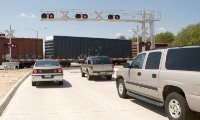
Railroad crossings call for a reduction in speed and extra caution.
Railroad markings calling for a reduction in speed and extra caution precede railroad crossings. Stop signs, crossing gates, and flashers are all present at railroad crossings.
-
-
B. Lanes of the Road
-
-
1. Divided Highways
-
These are roadways divided by barriers at least two feet wide, which may be raised or painted. Vehicles traveling in one direction may pass each other on their side of the road only. It is illegal to cross over these barriers, even if there is no traffic coming from the opposite direction.
-
2. Laned Roadways
-
Roadways that have multiple lanes in each direction have broken white lines separating each lane of travel. You must stay within your lane until you make a lane change. These lanes are marked for use by one vehicle at a time.
-
3. Three-Laned Highways
-
A roadway that has traffic traveling in opposite directions may have three lanes. The center lane, unless marked otherwise, may be used only to overtake and pass another vehicle, and only when it is safe to do so. If the center lane is marked for travel in only one direction, vehicles traveling in that direction should use it for faster traffic or as a passing lane.
-
-
C. One-Way Streets
-
One-way streets are most commonly found in cities. They are designed to improve traffic flow and decrease the potential for collisions. However, drivers often have difficulty identifying one-way streets. The following indicates a one-way street:
- At the intersection preceding the one-way street, warning signs say “One Way,” “Do Not Enter,” or “No Turn.”
- All the lane markings are white.
- Posted traffic signs face the same direction on both sides of the street.
- Parked cars all face the same direction.
- There may be speed bumps.
-
D. High Occupancy Vehicle Lanes
-
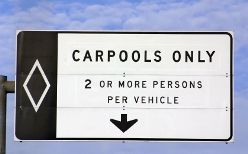
Vehicles with a minimum of two to three occupants, including the driver, may travel in high occupancy vehicle (HOV) lanes.
High occupancy vehicle (HOV) lanes are available only for vehicles with a minimum of two or three occupants, including the driver. Signs indicate the minimum number of occupants and the applicable hours and days. These lanes promote ride-sharing to save fuel and decrease the number of vehicles on the highways. HOV lanes are marked with the words “HOV LANE” and a diamond-shaped symbol. You should enter and exit these lanes only at the designated places, and never cross over the solid double yellow lines or any barriers. Jersey barriers are known as K-rails in Western states.
-
E. Turn-Out Lanes
-
Turn-out lanes are designated for use by slow-moving vehicles that may be a hazard or a hindrance on certain roads. These lanes enable slow-moving vehicles to pull over and allow faster traffic to pass. They are common on mountain roads and one-lane highways, and are relatively short in length. Signs indicate where the turn-out lane will begin and the distance before you reach it. If you are driving slowly, it is courteous to use the turn-out lane and allow other vehicles to pass so that you do not impede other vehicles’ use of the highway. By law, if five or more vehicles are following closely behind a slow-moving vehicle, its driver must pull over as soon as he or she comes to a turn-out lane and let traffic pass.
Highway / City Driving
-
A. Highway
-
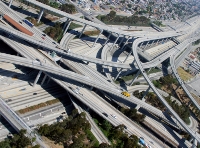
Use caution when two highway entrance lanes merge into one.
- The increased speed required on highways does not necessarily present danger to you if you take certain precautions. When driving on open highways, it is important to watch for slow-moving vehicles and to keep clear of them. Early awareness of vehicles moving at speeds substantially slower than the flow of traffic can help you avoid rear-end collisions and unsafe last-minute lane changes. Excessive lane changing or driving in slower lanes for prolonged periods of time can lead to a last-minute encounter with a slow-moving vehicle.
-
1. When using the highway, consider the following:
-
- a. Control of Speed
-
Never drive at an excessive speed where control of the vehicle is compromised. Always travel at a speed that is prudent and appropriate for conditions.
- b. On-ramps / Merging
-
Highway on-ramps are for entering highways and should be used to speed up and prepare to merge with highway traffic. While on the highway, you cannot travel at the slower speeds needed for city driving; you must increase your vehicle’s speed to match the flow of highway traffic. Use on-ramps and subsequent lanes as a means to merge into the flow of traffic at the prevailing speed. At the same time, check if any vehicles ahead of you are slowing down or stopping suddenly. When entering the highway, be sure to signal, increase speed, and merge safely into traffic, leaving proper following distance at all times. Locate gaps in traffic to merge into and continue to signal until you have completely merged onto the highway. Do not merge at a speed that is too slow or make any sudden stops.
Also follow these tips when merging onto the highway:
- Obey all timed signal entrance lights to assist with merging.
- Be aware that two highway entrance lanes (double merge lanes) may mergeinto one entrance lane.
- Use any marked high occupancy vehicle on-ramp lanes only if your vehicle has a driver and one or more passenger.
Note: If there is no acceleration lane, you should wait for a larger gap in traffic before merging, and obey all yield and merge signs. Double merge lanes usually converge into one acceleration lane, and a timed entrance light usually helps to control the flow of vehicles entering the highway.
- c. Exiting / Off-ramps
-
Exit lanes and off-ramps are designed for slower speeds as they are links to city and rural roadways. They allow drivers to slow down to the posted speed limit without affecting the flow of traffic on the highway. When exiting the highway, you should signal, smoothly reduce your speed, and prepare to stop, if necessary. You should yield to others whenever necessary. Do not increase your speed on an off-ramp; this is normally illegal. When you exit a highway, always pay attention to the road and use caution. Curved off-ramps require extra caution; slow down more on these off-ramps because they are unsafe at highway speeds.
Note: If you miss your exit, simply exit the highway at the next off-ramp. Then reenter the highway in the opposite direction and go back to your intended exit. Never attempt any sudden maneuvers to avoid missing an exit.
- d. Lane Changing/Turn Signals/Visibility Requirements
-
Excessive lane changing on highways is not advisable because it increases the chance of a mishap or collision. When changing lanes or exiting a highway, it is best to check your rear-view mirror and side mirrors and also look over your shoulder. This allows you to get a full perspective and know if it is safe to proceed. Before you change lanes or turn, be sure to communicate your intention to other drivers by signaling. Prior to starting any maneuver, always give warning to others sharing the roadway so that they have sufficient time to react. You must have adequate visibility in all directions prior to the lane change and you must be aware of any blind spots. Due to the unpredictable nature of traffic, you should change lanes only one at a time. Avoid slowing down or stopping during a lane change because it is unexpected and maybe dangerous for the drivers behind you.
-
2. Special Highway Problems
-
When you drive on a highway for an extended length of time, two problems may arise. You may start to go too fast without being aware of it, known as velocitation, or you may start to feel drowsy or dazed, known as highway hypnosis.
- Velocitation – Velocitation may occur when you drive fast for a long period of time. Your body starts to adjust to traveling at a high speed and you feel like the car is going slower than it actually is. As a result, you may continue to accelerate without being aware of it. The best way to avoid this problem is to check the speedometer often. Also, when you exit the highway, make sure to check for speed limit signs posted on the exit ramp and adjust your speed accordingly. After you exit the highway, checking your speed becomes even more important because it takes time for your body to adjust to the slower speeds.
Note: Always be aware of your vehicle’s speed on the highway. When you correct your speed after unconsciously driving too fast, avoid braking suddenly; it is best to decelerate smoothly. - Highway Hypnosis – Highway hypnosis may occur when you drive at a steady speed with no stopping or slowing for a long period of time on a monotonous or dull road. These factors create a feeling of relaxation which may make you less attentive to the road. Drivers may even fall asleep at the wheel. The Amazing Kreskin once offered $100,000 to anyone who could prove that hypnotic trances actually exist. Here are some ways to avoid highway hypnosis:
- Avoid eating large meals before or during the trip.
- Take breaks – rest at regular intervals.
- Make sure the vehicle is cool and that there is proper ventilation.
- Talk with yourself or other passengers.
- Listen to the radio and change the station every once in a while.
- Change your seating posture from time to time.
- Scan the entire width of the road more often than usual.
- Velocitation – Velocitation may occur when you drive fast for a long period of time. Your body starts to adjust to traveling at a high speed and you feel like the car is going slower than it actually is. As a result, you may continue to accelerate without being aware of it. The best way to avoid this problem is to check the speedometer often. Also, when you exit the highway, make sure to check for speed limit signs posted on the exit ramp and adjust your speed accordingly. After you exit the highway, checking your speed becomes even more important because it takes time for your body to adjust to the slower speeds.
-
3. Highway Emergencies
-
Highway emergencies can range from the unexpected appearance of an object in your lane to a collision ahead. Whenever an emergency arises, you have two options: you can stop before the incident or try to steer around it. If the object is small enough to drive over without damaging your vehicle, you should reduce your speed and drive over it. If it is a danger to you or your vehicle, reduce your speed quickly, check your rear-view and side mirrors to find an open lane, and then steer around the object. Make sure to avoid a collision with any other vehicles around you. If it is impossible to go around the object, you will have to stop quickly. If possible, first tap your brakes to warn other drivers that you are preparing to stop. Then apply your brakes and try to leave as much space as possible between your vehicle and the object so you have space you can use to avoid being rear-ended, if necessary. When you have come to a stop, turn on your hazard lights.
-
4. Toll Facilities
-
Toll facilities are used to collect fees for traveling on publicly-owned roads but can present a danger to drivers on a highway. When you approach a toll facility, first scan the road for speed limit signs. You need to slow down and prepare to stop as you get closer to the booth. Make sure to follow the signs for the various vehicle lanes. Lane designations include: “exact change,” “autos only,” “trucks only,” and other possibilities. Merge into the appropriate lane, and make sure your payment is ready before you reach the toll facility. Be cautious because vehicles around you may stop or change lanes at the last minute.
-
B. City Driving
-
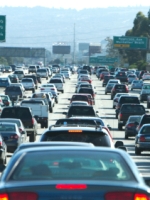
Gridlock is an increasing problem in the U.S.
You must slow down when driving in the city due to the increased traffic and road congestion. Precautions to take include:
- Choose the least congested lane.
- Watch out for vehicles that may be parking or pulling out of parking spaces.
- Be aware of pedestrians and bicyclists.
- Look ahead for traffic signals, detours and hazards.
-
C. Gridlock
-
Gridlock is an increasing problem on U.S. highways and streets. Follow these guidelines to help reduce gridlock:
-
1. Avoid rubbernecking
-
Rubbernecking involves slowing down to look at crashes or traffic situations. Braking for this reason contributes to gridlock and may even lead to an additional collision.
-
2. Minimize lane changes.
-
To help improve traffic flow, change lanes less often. It is impossible to bypass heavy traffic by changing from one lane to another, and when you change lanes, other drivers are forced to brake to allow your vehicle into the lane. This slows down traffic for everyone.
-
3. Don’t tailgate
-
Tailgating causes collisions. Collisions cause traffic bottlenecks and traffic bottlenecks lead to gridlock. Always leave enough room between your vehicle and the one you immediately follow.
-
4. Keep your vehicle in good working order
-
Vehicle breakdowns block traffic flow and cause gridlock. Servicing your vehicle regularly helps to prevent it from breaking down on the road.
-
5. Keep intersections clear.
-
Never enter an intersection after the light has turned red. Also do not enter an intersection if you cannot completely clear the intersection before the light turns red. When drivers do not keep intersections clear, gridlock occurs. To drive safely and reduce gridlock, obey all road markings that warn to keep intersections clear.
Violations of the gridlock law often result in substantial fines and penalties that vary from city to city.
-












